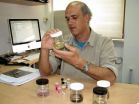Penn researchers identify protein that predicts post-concussion severity in professional athletes
Simple blood test could inform head injury-related 'return to play' decisions
2014-11-25
(Press-News.org) PHILADELPHIA - New Penn Medicine research has found that elevated levels in the blood of the brain-enriched protein calpain-cleaved αII-spectrin N-terminal fragment, known as SNTF, shortly after sports-related concussion can predict the severity of post-concussion symptoms in professional athletes. The complete findings were released today in the Journal of Neurotrauma.
This new study builds on previous research from this group showing that elevated blood levels of SNTF on the day of a mild traumatic brain injury treated in the emergency room predicted those patients who would go on to suffer diffuse axonal injury and long-term cognitive dysfunction.
"We extended this biomarker research to the domain of professional sports to test its merit as an objective and rapid way to determine players' severity of brain injury," says lead author, Robert Siman, PhD, Research Professor of Neurosurgery at Penn. "This blood test may aid neurobiologically-informed decisions on suitability for return to play following a sports-related concussion."
The study, conducted in collaboration with Henrik Zetterberg, MD, PhD and Kai Blennow, MD, PhD, of the Sahgrenska Academy at University of Gothenburg, Sweden, and their colleagues, enrolled 288 players in the top Swedish professional ice hockey league. Each of the 28 players who suffered a concussion during the first half of the 2012-2013 season received serial blood draws and was evaluated daily for symptom resolution using the latest guidelines for treatment of sports concussions. Eight of the concussed players were symptom-free within a few days of their injury, but 20 of the players had persistent post-concussion symptoms requiring they be withheld from play six days or longer. An additional 45 players were evaluated during the preseason, 17 of whom were also tested before and after a concussion-free training game.
Compared to those players who were not concussed, or whose concussion symptoms resolved rapidly, the researchers found an increase in the blood SNTF concentration from one hour up to 144 hours post-concussion in those players experiencing persisting post-concussion symptoms. SNTF is a protein that is present at undetectable levels in healthy human brains, but is produced under conditions where nerve cells are traumatized and begin to die. Concussions that lead to lasting brain dysfunction cause SNTF to accumulate in vulnerable long axon tracts of the brain, and its blood elevation is a measure of this diffuse axonal injury.
"These results show that SNTF has promise as a blood biomarker for sports-related concussion and beyond. High blood levels of SNTF appear to identify acute brain damage that corresponds with persisting symptoms after concussion. These observations lend further support to the growing awareness that concussion is not trivial, since it can induce permanent brain damage in some individuals," agree Siman and senior author, Douglas H. Smith, MD, professor of Neurosurgery and director of the Center for Brain Injury and Repair at Penn.
INFORMATION:
This work was funded by grants from the NIH (P01 NS0556202), the Swedish Medical Research Council and the Perelman School of Medicine at the University of Pennsylvania.
Editor's note: Dr. Siman is an inventor on a U.S. patent application for SNTF as a diagnostic and prognostic blood biomarker for mild traumatic brain injury. Drs. Zetterberg and Blennow are listed as coinventors on a U.S. patent application for plasma tau as a brain injury marker.
Penn Medicine is one of the world's leading academic medical centers, dedicated to the related missions of medical education, biomedical research, and excellence in patient care. Penn Medicine consists of the Raymond and Ruth Perelman School of Medicine at the University of Pennsylvania (founded in 1765 as the nation's first medical school) and the University of Pennsylvania Health System, which together form a $4.3 billion enterprise.
The Perelman School of Medicine has been ranked among the top five medical schools in the United States for the past 17 years, according to U.S. News & World Report's survey of research-oriented medical schools. The School is consistently among the nation's top recipients of funding from the National Institutes of Health, with $392 million awarded in the 2013 fiscal year.
The University of Pennsylvania Health System's patient care facilities include: The Hospital of the University of Pennsylvania -- recognized as one of the nation's top "Honor Roll" hospitals by U.S. News & World Report; Penn Presbyterian Medical Center; Chester County Hospital; Penn Wissahickon Hospice; and Pennsylvania Hospital -- the nation's first hospital, founded in 1751. Additional affiliated inpatient care facilities and services throughout the Philadelphia region include Chestnut Hill Hospital and Good Shepherd Penn Partners, a partnership between Good Shepherd Rehabilitation Network and Penn Medicine.
Penn Medicine is committed to improving lives and health through a variety of community-based programs and activities. In fiscal year 2013, Penn Medicine provided $814 million to benefit our community.
ELSE PRESS RELEASES FROM THIS DATE:
2014-11-25
TORONTO, Nov. 29, 2014--A chemical produced in the pancreas that prevented and even reversed Type 1 diabetes in mice had the same effect on human beta cells transplanted into mice, new research has found.
GABA, or gamma-aminobutryic acid, is an amino acid produced by the same beta cells that make and secrete insulin.
Drs. Gerald Prud'homme and Qinghua Wang of the Keenan Research Centre for Biomedical Sciences of St. Michael's Hospital published a paper in 2011 showing for the first time that GABA injections not only prevented Type 1 diabetes in mice, but even reversed ...
2014-11-25
LIVERMORE, Calif. - Nanoporous metals -- foam-like materials that have some degree of air vacuum in their structure -- have a wide range of applications because of their superior qualities.
They posses a high surface area for better electron transfer, which can lead to the improved performance of an electrode in an electric double capacitor or battery. Nanoporous metals offer an increased number of available sites for the adsorption of analytes, a highly desirable feature for sensors.
Lawrence Livermore National Laboratory (LLNL) and the Swiss Federal Institute of ...
2014-11-25
WACO, Texas (Nov. 25, 2014) - Note to venture capitalists: Entrepreneurs are watching to see if you're naughty or nice.
A recently published study of more than 550 decisions and responses from 144 experienced entrepreneurs reveals that "knowledge of explicit ethical or unethical behavior (by venture capitalists) profoundly shapes the entrepreneurs' willingness to partner."
Baylor University researcher Matthew S. Wood, Ph.D., assistant professor of entrepreneurship in Baylor's Hankamer School of Business, co-authored the study, "Take the money or run? Investors' ethical ...
2014-11-25
A measles vaccine made of fine dry powder and delivered with a puff of air triggered no adverse side effects in early human testing and it is likely effective, according to a paper to be published November 28 in the journal Vaccine. The paper is now available online.
In 2013, measles killed 145,700 people, most of them children, according to the World Health Organization. That's despite the fact that the conventional injectable vaccine against the measles virus is effective.
"Delivering vaccines in the conventional way, with needle injections, poses some serious challenges, ...
2014-11-25
Treatment for obstructive sleep apnea with continuous positive airway pressure (CPAP) or mandibular advancement devices (MADs) can lead to modest improvements in depressive symptoms, according to a study published by Marcus Povitz, Carmelle Bolo, and colleagues from University of Calgary, Canada, in this week's PLOS Medicine.
The researchers identified 22 randomized controlled trials that investigated the effects of CPAP or MAD treatment on patients with obstructive sleep apnea and that measured depressive symptoms before and after treatment. By pooling the results from ...
2014-11-25
HOUSTON - (Nov. 25, 2014) - An international collaboration of scientists including Baylor College of Medicine has completed the first genome sequence of a myriapod, Strigamia maritima - a member of a group venomous centipedes that care for their eggs - and uncovered new clues about their biological evolution and unique absence of vision and circadian rhythm.
Over 100 researchers from 12 countries completed the project. They published their work online today in the journal PLOS Biology.
"This is the first myriapod and the last of the four classes of arthropods to have ...
2014-11-25
The arthropods are one of Earth's real success stories, with more species of arthropod than in any other animal phylum, but our knowledge of arthropod genomes has been heavily skewed towards the insects. Recent work has furnished us with the genome sequences of an arachnid and a crustacean, but the myriapods (centipedes and millipedes) have remained the one class of arthropods whose genomes are still in the dark.
An international team of scientists (over 100 from 15 countries) with Stephen Richards (Baylor College of Medicine) as senior author has now sequenced the genome ...
2014-11-25
Centipedes, those many-legged creatures that startle us in our homes and gardens, have been genetically sequenced for the first time. In a new study in the journal PLoS Biology, an international team of over 100 scientists today reveals how this humble arthropod's DNA gave them new insight into how life developed on our planet.
Centipedes are members of the arthropods, a group with numerous species including insects, spiders and other animals. Until now, the only class of arthropods not represented by a sequenced genome was the myriapods, which include centipedes and ...
2014-11-25
Learning-related brain activity in Parkinson's patients improves as much in response to a placebo treatment as to real medication, according to a new study by researchers at the University of Colorado Boulder and Columbia University.
Past research has shown that while Parkinson's disease is a neurological reality, the brain systems involved may also be affected by a patient's expectations about treatment. The new study, published in the journal Nature Neuroscience, explains how the placebo treatment -- when patients believe they have received medication when they have ...
2014-11-25
Endangered Snake River sockeye salmon are regaining the fitness of their wild ancestors, with naturally spawned juvenile sockeye migrating to the ocean and returning as adults at a much higher rate than others released from hatcheries, according to a newly published analysis. The analysis indicates that the program to save the species has succeeded and is now shifting to rebuilding populations in the wild.
Biologists believe the increased return rate of sockeye spawned naturally by hatchery-produced parents is high enough for the species to eventually sustain itself in ...
LAST 30 PRESS RELEASES:
[Press-News.org] Penn researchers identify protein that predicts post-concussion severity in professional athletes
Simple blood test could inform head injury-related 'return to play' decisions



